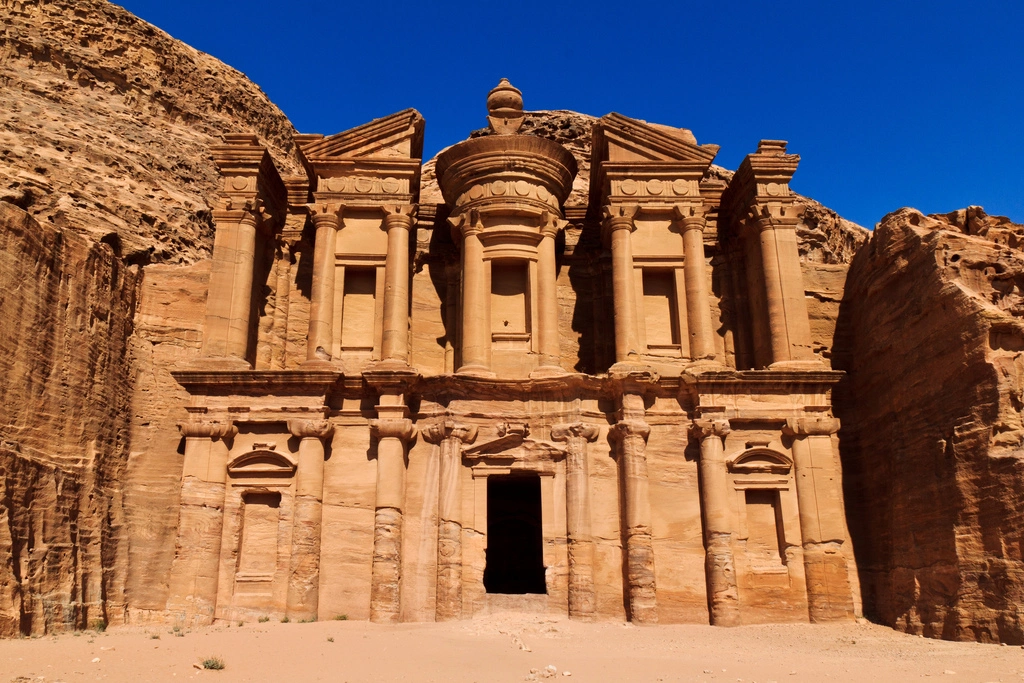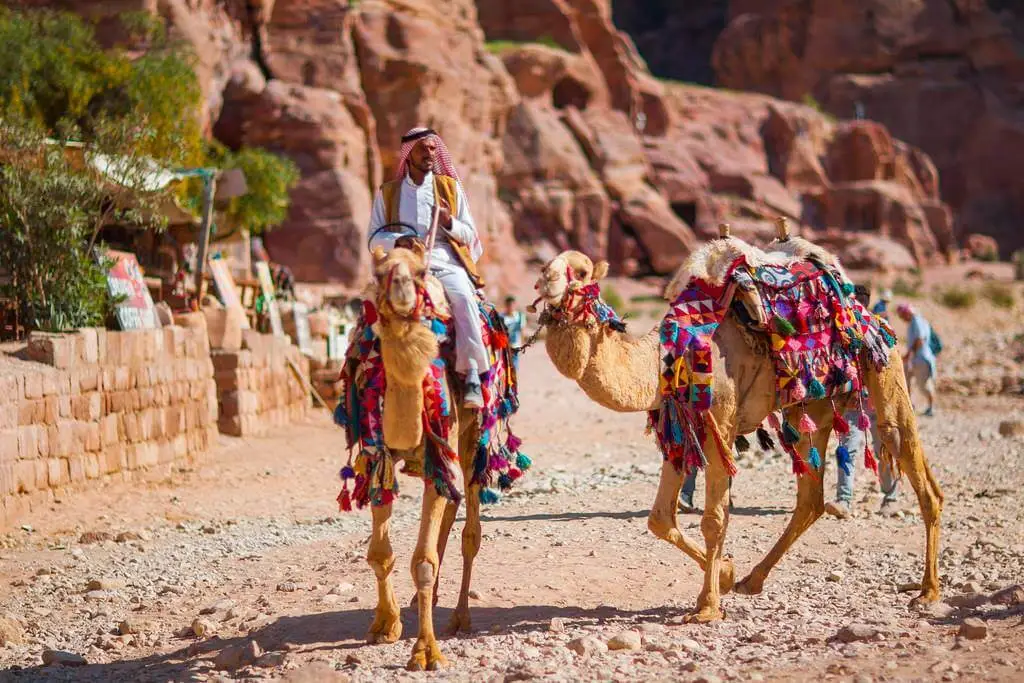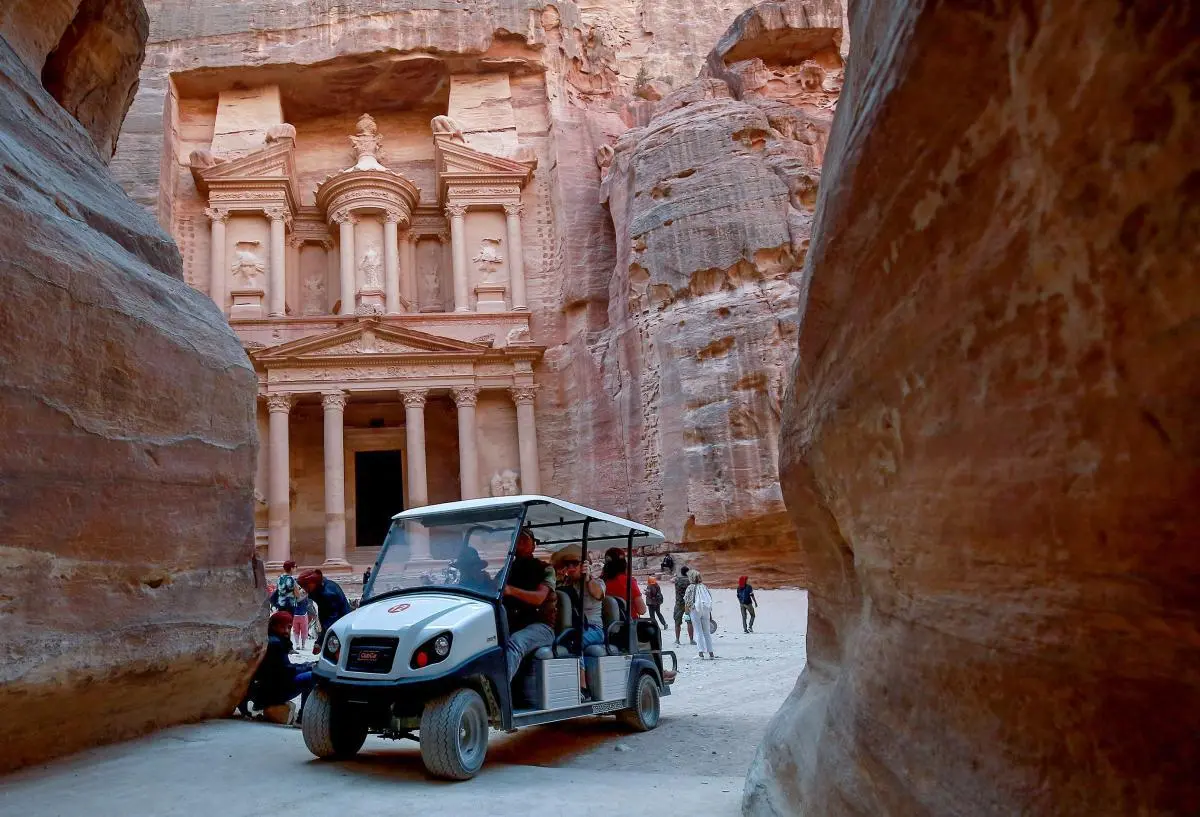The rock city Petra is on top of the list of each traveller to Jordan. Here we briefly list the most important information to help you plan your visit.
About Petra
Petra was founded in the 3rd century BC as the capital of the Nabataean Arabs. Due to its proximity to trade routes, the Nabataeans established here a major trading center. Often referred to as Rose City due to the color of the stone, this magnificent place is famous for its impressive rock architecture and water channel system. Since 1985 Petra is a UNESCO World Heritage Site and in 2007 was named as one of the New Seven Wonders of the World.
Where is Petra?
Petra is located in the south of Jordan. From Amman or Dead Sea hotel area to Petra it is a 3 hours’ drive, from Aqaba to Petra a 2 hours’ drive and from Wadi Rum desert to Petra a 1.5 hours’ drive.
Opening Hours
Petra Archaeological Park is open on daily basis from sunrise to sunset. The Visitor Centre is open in summer from 06:00 until 17:30 and in winter from 06:00 until 16:00.
Cost of Entry Ticket Per Person
● 1-day pass: 50 JD.
● 2-day pass (2 consecutive days): 55 JD.
● 3-day pass (3 consecutive days): 60 JD.
● Day visitors from Israel: 90 JD.
● Arab Passport Holders: 30 Jordanian Dinar.
● Locals and Residents: 10 Jordanian Dinar.
● Children below 12 years are free of charge.
Tickets can be paid for in cash or by credit card. You need to submit your passport at the Visitor Centre.
● The extra ticket for the Al Khubtha Trail or the Treasury View Trail is charged with 10 Jordanian per person inside Petra Park. Cash payment is accepted only.
Petra by Night Ticket
Petra by Night is charged as a separate ticket. The rate is 30 Jordanian Dinar per person. Children under 10 years are free of charge. Petra by Night takes place from Sunday to Thursday starting at 20:30 and ending about 22:30. Tickets can be purchased at the Visitor Centre or at your Petra hotel reception. A valid daylight ticket for Petra or the Jordan Pass are needed.
English speaking, local guide fees in Petra
If you want to learn about Petra, a local guide can improve your experience while visiting the ancient site. Several trails can be visited without a guide like the main trail and from there the extensions to the High Place of Sacrifice or the Monastery El Deir. However, for several trails in Petra a guide is mandatory, as the path is not always easy to find. Guide fees are as follows:
● Standard Tour (Main Trail): 50 Jordanian Dinar.
● Main Trail & High Place of Sacrifice: 100 Jordanian Dinar.
● Main Trail & Monastery El Deir: 100 Jordanian Dinar.
● Main Trail & Al Khubtha Trail: 100 Jordanian Dinar.
● Trail High Place of Sacrifice & Wadi Farasa & Garden Tomb: 120 Jordanian Dinar.
● Trail Little Petra & Monastery El Deir & Main Trail: 150 Jordanian Dinar.
● Trail to Jabal Haroun: 150 Jordanian Dinar.
What to wear
Wear sturdy shoes, comfortable to walk around all day. Especially in summer bring a hat, sunglasses, sun block, light, covering clothes. In winter it is cold and warmer clothes are needed. Practical is in general a small backpack, bottled water and snacks.
Best Time to Visit Petra
With view to the weather, spring (Mar to May) and autumn (Sep to Nov) are the best months to visit Petra. Summer can get very hot. We recommend starting your visit as early as possible. Plus, in the early morning there are less visitors, and you have the Siq and the Treasury nearly to yourself, which is a great experience. In winter it can be cool, and on some days rain might occur.
How much time I need to explore Petra?
The Archaeological Park of Petra measures 264 square km. Most visitors stay one day in Petra. This gives you time to see the lower parts of Petra with the Siq, the Treasury (Al Khazneh), the Street of Facades, the Royal Tombs, Qasr Al Bint and to hike up to the High Place of Sacrifice or the Monastery El Deir. But if you are interested in seeing more of Petra and hiking along less frequented routes, a second or even a third day in Petra is necessary. For the hiking parts a guide is strongly recommended or even mandatory.
Which attractions can be seen along the main trail in Petra?
Obelisk Tomb ● Siq or Canyon ● Al Khazneh or Treasury ● Street of Façades ● Royal Tombs
● Roman Theatre ● Colonnaded Street ● Qasr Al Bint.
How many km I have to walk in Petra?
Be prepared to do a lot of walking. Certainly, it depends on which monuments want to see in Petra. As an idea, from the entrance gate to the end of the Siq, the way leading into Petra, it is 1.2 km walk one way. The regular standard tour in the lower parts of Petra covers about 5 km.
Modes of Transportation in Petra:
● Electric golf carts shorten the walking distance in Petra. Each cart can take up to 5 people. It is not possible to book a seat in advance, you have to do it on spot in Petra. The golf carts serve the route Petra Visitor Centre to Treasury (one way) with a price of 15 Jordanian Dinar per seat. The route Petra Visitor Centre – Treasury – Petra Visitor Centre is charged with 25 Jordanian Dinar per seat. Children under 3 years are free of charge. Payments need to be done in cash.
● Short horse ride Petra. The admission fee Petra includes a 700 meters short horse ride from the main gate until before entrance to the Siq. The ride is not compulsory, and the horse handler expects a tip of 5 Jordanian Dinar.
● Donkey rides are also offered in Petra. But we don’t recommend using donkeys, as they are often treated badly, and their hooves are damaging the sandstone of Petra.
● Clients planning on hiking from Little Petra to the Monastery El Deir need to use a 4x4 to reach the beginning of the trail. The transportation cost is 5 Jordanian Dinar per person.
Food and Drinks in Petra
At the end of the main trail in Petra you find 2 restaurants: the Nabatean Tent Restaurant and the Basin Restaurant, both serving buffet lunch. Bottled water, tea, coffee, snacks can be purchased at simple kiosks outside and inside the site. If you prefer, you can also bring a packed lunch from your hotel when entering Petra.
Souvenirs
Like in all touristic sites you find in Petra stalls and eager sellers trying to make a deal with souvenirs. Some are persistent and if you feel hassled, it is best to ignore the offers. Just shake your head as a sign you have no interest or say “la, shukran”. Don’t buy rock fragments, encouraging vendors to break fragments from the Petra monuments, or fall for faked Nabataean coins.
Toilets in Petra
Beside the Visitor Centre, there are toilets in a cave below the Royal Tombs, opposite the Roman Theatre, and close to the restaurant area.
Disclaimer:
● The information provided by Petra Nights Tours is for general informational purposes only. Prices and procedures can change anytime without prior notice.
● Petra Nights Tours is not liable for any mistreatment or abuse of animals in Petra. If you witness an incident, we do advise you to directly report to tourist police (phone +962 3 215 6487) or Petra Development & Tourism Regional Authority (phone +962 3 215 7093) or Ministry of Tourism (phone +962 6 460 3360).



